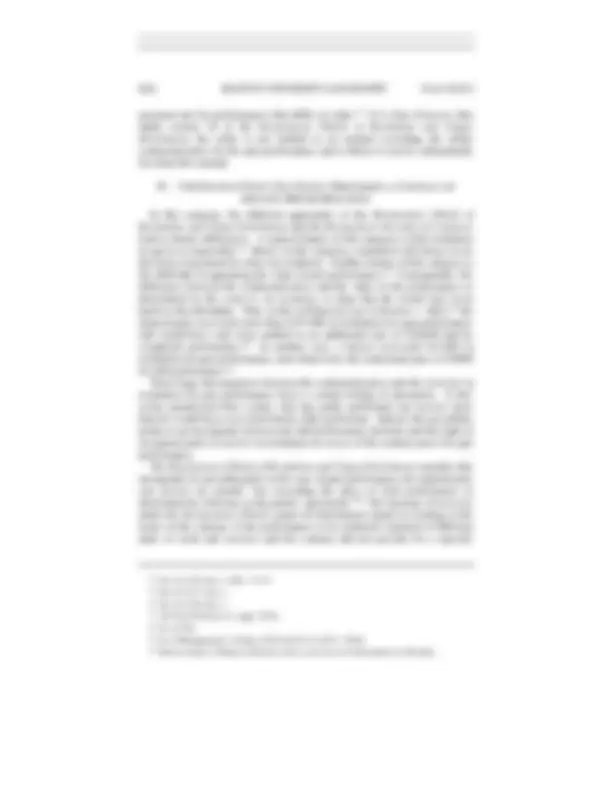











Study with the several resources on Docsity

Earn points by helping other students or get them with a premium plan


Prepare for your exams
Study with the several resources on Docsity

Earn points to download
Earn points by helping other students or get them with a premium plan
Community
Ask the community for help and clear up your study doubts
Discover the best universities in your country according to Docsity users
Free resources
Download our free guides on studying techniques, anxiety management strategies, and thesis advice from Docsity tutors
The legal concepts of rescission of contracts and restitution, focusing on their differences under English law. It covers various scenarios, including rescission for breach and defect in formation, part performance, and full performance. The document also explores the implications of these concepts for the injured party and the party in breach, as well as the limitations and exceptions to the rules. It provides examples of significant cases and references to relevant legal texts.
What you will learn
Typology: Summaries
1 / 16

This page cannot be seen from the preview
Don't miss anything!










The purpose of this Article is to examine some aspects of the remedy of rescission and, in particular, the extent to which the terms of the extinguished contract remain relevant for ordering the parties’ rights. At the outset, it is important to clarify a fundamental distinction between contracts rescinded on the ground of a “defect in the will” of one or both parties and contracts rescinded on the ground of their breach. The term “defect in the will” is used as a general concept embracing a large group of conceivable defects in the formation of a contract – notably fraud, misrepresentation, mistake, duress, and undue influence.^1 Their common feature is that they undermine the very foundation of the contract, so that the terms of the contract do not represent the “free will” of the party involved. 2 The contract can be avoided ab initio by the induced party. 3 Consequently, the terms of the rescinded contract impose no limitation on the rights of a party who did not really agree to be bound by such a contract. Thus, suppose that because of D ’s fraud, P agrees to perform certain work for D at a cost of
∗ (^) Professor (Emeritus), Faculty of Law, Tel Aviv University; Member, Israel Academy
of Sciences and Humanities; Member, International Academy of Comparative Law; Minister of Justice, Israel, 2007-2009. (^1) See, e.g. , Nili Cohen, Good Faith in Bargaining and Principles in Contract Law , 9 TEL
AVIV U NIV. S TUD. L. 249, 250 (1989). A contract may also be voided for other defects in formation, such as illegality or failure to meet the requirement of a writing. See, e.g. , RESTATEMENT (S ECOND ) OF CONTRACTS § 36 cmt. c (1981). (^2) See Cohen, supra note 1, at 251, 301. (^3) See, e.g. , RESTATEMENT (S ECOND ) OF CONTRACTS § 167 illus. 1; id. § 175.
812 BOSTON UNIVERSITY LAW REVIEW [Vol. 92:
$5000. Having performed about half of the work, P discovers D ’s fraud and rescinds the contract. P is entitled to restitution for the value of the work done (in quantum meruit), an amount not limited by the terms of the contract, since
(^4) The position of the party responsible for the fraud is less happy. If in the above
example D performed the work and D was the fraudulent party, D ’s claim for quantum meruit for the value of the work done, if allowed, will be limited to the proportionate part of the amount stipulated in the contract. See generally RESTATEMENT (T HIRD ) OF R ESTITUTION AND UNJUST E NRICHMENT § 38 (2011). (^5) See, e.g. , Chilingrian v. Kloian, No. 229186, 2003 Mich. App. LEXIS 1240, at *1, *
(Mich. Ct. App. May 22, 2003); Taylor & Jennings, Inc. v. Bellino Bros. Constr. Co., 483 N.Y.S.2d 813, 815 (N.Y. App. Div. 1984). This result may ensue even if D ’s fraud did not relate to elements bearing upon the cost of the work or its value, but to other elements relating to the contract. See RESTATEMENT (S ECOND ) OF CONTRACTS § 376. (^6) See Cohen, supra note 1, at 251. (^7) Brian Coote, The Effect of Discharge by Breach on Exception Clauses , 28 C AMBRIDGE
L.J. 221, 226 (1970); Marion Hetherington, Contract Damages for Loss of Bargain Following Termination: The Causation Problem , 6 UNIV. N.S.W. L.J. 211, 211 (1983). (^8) See G.H. TREITEL, R EMEDIES FOR BREACH OF CONTRACT 382-85 (1988); Coote, supra
note 7, at 227. (^9) See J. BEATSON , ANSON ’ S L AW OF CONTRACT 581-82 (28th ed. 2002); Coote, supra note
7, at 226; Steven Lurie, Towards a Unified Theory of Breach: Tracing the History of the Rule that Rescission Ab Initio Is Not a Remedy for Breach of Contract , 19 J. CONTRACT L. 250, 250 (2003). (^10) TREITEL, supra note 8, at 383. (^11) BÜRGERLICHES GESETZBUCH [BGB] [CIVIL CODE], Aug. 18, 1896,
REICHSGESETZBLATT [RGB L.] 195, as amended, § 346 (Ger.), available at http://dejure.org/gesetze/BGB/346.html; S TEPHAN LORENZ & T HOMAS RIEHM , L EHRBUCH ZUM NEUEN S CHULDRECHT 216-23 (2002); TREITEL, supra note 8, at 382-92. The position of English law on the subject is complex, but it recognizes the right of restitution in a great
814 BOSTON UNIVERSITY LAW REVIEW [Vol. 92:
agreed upon for full performance. The same position has been adopted by the Restatement (Second) of Contracts ,^18 subject to the qualification that if the injured party has already fully performed his part, his claim is subject to the “full performance” doctrine and is therefore limited to the amount contractually agreed upon.^19 This Article is concerned with the incongruity on this point between the Restatement (Second) of Contracts and the new Restatement (Third) of Restitution and Unjust Enrichment. This Article is based on the following premises:
(Cal. Ct. App. 1933). English, Canadian, and Australian decisions generally adopt a similar approach. See P ETER D. M ADDAUGH & JOHN D. M C CAMUS, T HE L AW OF RESTITUTION 591- 96 (2d ed. 2004). For a recent Australian example, see Sopov v Kane Constrs. Pty. Ltd. (2009) 257 ALR 182 (Austl.). (^18) See RESTATEMENT (S ECOND ) OF C ONTRACTS § 373 cmt. d, illus. 12 (1981). (^19) See id. § 373 cmt. b, illus. 5; P ALMER , supra note 17, at 378-89. The full performance
doctrine has been also adopted in England and Canada. See M ADDAUGH & M C C AMUS, supra note 17, at 591-95. (^20) Compare RESTATEMENT (T HIRD ) OF R ESTITUTION AND UNJUST E NRICHMENT § 38 cmt. c
(2011), and RESTATEMENT (S ECOND ) OF CONTRACTS § 261, with RESTATEMENT (T HIRD ) OF RESTITUTION AND UNJUST E NRICHMENT § 34 cmt. c, illus. 9. (^21) O LIVER W ENDELL HOLMES, T HE COMMON L AW 1 (1909).
I shall now examine a number of typical situations in which the question arises – that is, whether or not a party recovering on a quantum meruit basis should be limited to the amount stipulated in the contract.
I. P ERFORMANCE T HAT H AS NOT Y ET B EEN R ENDERED The general rule is that rescission releases both parties from what has been termed their unperformed “primary” contractual obligations. 22 Thus, if the buyer ( B ) agrees to buy property from the vendor ( V ) and the agreement is rescinded, B is relieved from his obligation to pay the price ( B ’s primary obligation) and V is relieved from his obligation to transfer the property ( V ’s primary obligation). This rule applies irrespective of whether the contract has been rescinded due to a “defect in the will” of one of the parties (such as fraud or duress) or due to a “fundamental” breach. Moreover, the rule is equally applicable to the injured party, the party in breach, and the party responsible for the defect in the other party’s will. 23 This, however, is not the end of the matter since the innocent party is entitled to damages – the breaching party’s “secondary” obligation.^24 In the following examples, assume that V is the breaching party and B is the innocent party:
(1) The price stipulated in the contract was $1000 and the value of the promised property was $1200. The contract was therefore profitable from B ’s point of view, as B expected to gain $200 from its performance, while from V ’s point of view, it was a losing contract. (2) The same price as in illustration (1), except that the value of the property was only $800, so that it was a losing contract from B ’s point of view and a profitable contract from V ’s point of view. In illustration (1), if the contract is rescinded on account of its breach, B is entitled to damages in the amount of $200.^25 Hence, despite the rescission of
(^22) The term “primary obligation” and the distinction between primary and secondary
obligations has been developed by Lord Diplock. See Photo Prod. Ltd. v. Securicor Transport Ltd., [1980] A.C. 827 (H.L.) at 848-49 (Eng.). The primary obligation relates to the performance due under the contract. The secondary obligation is the obligation to pay damages for breach of the primary obligation. Id. at 849. In case of rescission for fundamental breach, the parties are released from their primary obligations. But the terms of the contract remain relevant for the calculation of damages. Furthermore, other contractual provisions relating to secondary obligations (such as those imposing liquidated damages as well as exemption clauses) remain in force. Id. at 849-50. (^23) See id. at 849-50. (^24) Id. at 849. (^25) Cf. RESTATEMENT (S ECOND ) OF CONTRACTS § 344 cmt. a, illus. 1 (1981). If the
contract was rescinded on the ground of defect in its formation (e.g., misrepresentation), B is not entitled under contract theory to expectation (performance) damages because, ex hypothesis, the contract was not voluntarily made and therefore B is not entitled to derive the benefit that the contract was supposed to grant him. B may, however, have a cause of
pre-contract position, restitution is therefore incompatible with expectation damages, which look at the situation the party would have been in had the contract been performed.^29 Under Uniform Commercial Code section 2-711, however, the buyer may recover in both restitution and expectation damages.^30 I find the U.C.C. approach preferable. There is no reason to require election between restitution and damages.^31 The U.C.C. approach merely requires the flexibility of viewing the contract as rescinded to restore that which was given under the contract, while recognizing that the contract’s terms continue to operate for the purpose of damages. It is not very different from the flexibility required to conclude that the contract is rescinded for the purpose of absolving the parties from their duties to perform their primary obligations, while the contract’s terms continue to govern the calculation of expectation damages. Now consider the scenario of a losing contract for B that is rescinded on the ground of V ’s breach:
(4) The same facts as in Illustration (2), except that B paid the price of $1000 in advance. In this case, B is entitled to restitution of the amount paid, even though the property depreciated in value and is now worth only $800.^32 The fact that B would have lost $200 had V transferred the property has no effect on B ’s right to recover the $1000 in restitution. This means that V cannot deduct his potential profits on the breached contract from his liability in restitution. 33 Moreover, B is obviously not entitled to damages (even if it is assumed the damages can be added to restitution) since B suffered no loss.^34 This illustration demonstrates how, in a losing contract, restitution enables the injured party to escape the contractual allocation of the risk and avoid the loss that he would have suffered had the contract been performed. Hence, this category follows the same approach as that found in Part I, under which the contractual allocation of the risk is maintained (via the remedy of damages) when it operates in favor of the injured party; but it is disregarded (by virtue of restitution) when it would have operated in favor of the party in breach.
(^29) See RESTATEMENT (S ECOND ) OF C ONTRACTS § 373 cmt. a; id. § 378 cmt. d. (^30) U.C.C. § 2-711 (2005); see also P ERILLO , supra note 25, § 16.17; Richard R.W.
Brooks & Alexander Stremitzer, Remedies on and off Contract , 120 YALE L.J. 690, 701 n. (2011). (^31) But, of course, care must be taken to prevent duplication of payments, since restitution
often reduces the loss for which damages are awarded. See P ALMER , supra note 17, at 435. (^32) This result is also supported and explained by Brooks & Stremitzer, supra note 30, at
(^33) See RESTATEMENT (T HIRD ) OF R ESTITUTION AND UNJUST E NRICHMENT § 37 cmt. b,
illus. 2 (2011). (^34) See supra note 26.
818 BOSTON UNIVERSITY LAW REVIEW [Vol. 92:
This category deviates from the approach reflected in Parts I and II, though a similar result is sometimes reached. Let us examine the following illustrations:
(5) V agreed to sell goods to B for $1000. V transferred to B the goods, which lost part of their value and are subsequently worth only $800. B failed to pay. This case is governed by the full performance doctrine: When a party has fully performed his portion of a contract and the performance due by the non- performing party is the payment of a definite sum of money, the performing party has no right to restitution.^35 Consequently, V is not entitled to restitution. The contractual allocation of the risk, however, is maintained, since V can claim the price B agreed upon, $1000, which exceeds the value of the goods at the time of B ’s breach, thereby granting V the contractual gain.
(6) V agreed to sell goods to B for $1000. V transferred to B the goods, which increased in value and are subsequently worth $1200. B failed to pay. From V ’s point of view, this is a losing contract. But because this case is also governed by the full performance doctrine, restitution is not available to V. V is therefore unable to escape the contractual allocation of the risk. He can only recover the contractual price of $1000 and will therefore suffer the loss imposed upon him by the terms of the contract.^36 Hence, the full performance doctrine creates an exception to the rule reflected in illustrations (2) and (4), under which rescission and restitution enable the injured party to escape the consequences of a losing contract. The full performance doctrine applies also to “divisible” contracts that provide for payment of an agreed sum of money for the performance of a specific part of the contract, with such payment constituting full consideration for the part performed. 37 The full performance doctrine does not apply, at least in some states, when consideration is in the form of services to be rendered.^38 Also, by its own terms, the doctrine does not apply to part performance of an entire contract. The following illustration between a seller of grain ( S ) and a purchaser ( P ) reflects the problem that may arise:
(7) S undertook to supply 20 tons of Quality X grain and 20 tons of Quality Y grain for $10,000. After S supplied the 20 tons of Quality X grain, P repudiated the contract. In the meantime, the price of both
(^35) See supra note 19 and accompanying text. (^36) See RESTATEMENT (T HIRD ) OF R ESTITUTION AND UNJUST E NRICHMENT § 37 cmt. b,
illus. 4. (^37) RESTATEMENT (S ECOND ) OF CONTRACTS § 373 cmt. c (1981). (^38) See P ALMER , supra note 17, at 501.
820 BOSTON UNIVERSITY LAW REVIEW [Vol. 92:
payment rate for performances that differ in value. 44 It is clear, however, that under section 38 of the Restatement (Third) of Restitution and Unjust Enrichment , the seller is not entitled to an amount exceeding the whole contractual price for his part performance and is likely to receive substantially less than this amount.
IV. T HE INNOCENT P ARTY H AS P ARTLY P ERFORMED A C ONTRACT OF S ERVICES B EFORE R ESCISSION In this category, the different approaches of the Restatement (Third) of Restitution and Unjust Enrichment and the Restatement (Second) of Contracts lead to drastic differences. A typical feature of this category is that restitution in specie is impossible. 45 Hence, in this category, restitution will always be in the form of payment for what was rendered. Another feature of this category is the difficulty in appraising the value of part performance. 46 Consequently, the difference between the contractual price and the value of the performance as determined by the court is, on occasion, so large that the award may seem harsh to the defendant. Thus, in the well-known case of Boomer v. Muir ,^47 the injured party recovered more than $257,000 in restitution for part performance and would have only been entitled to an additional sum of $20,000 had he completed performance.^48 In another case, a lawyer recovered $13,000 in restitution for part performance, more than twice the contractual price of $ for full performance. 49 These huge discrepancies between the contractual price and the recovery in restitution for part performance leave a certain feeling of uneasiness. It also seems paradoxical that a party who has partly performed can recover more than he would have recovered had he fully performed. Indeed, this possibility points to an incongruity between the full performance doctrine and the right of an injured party to recover in restitution in excess of the contract price for part performance. The Restatement (Third) of Restitution and Unjust Enrichment remedies this incongruity by providing that, in the case of part performance, the injured party can recover an amount “not exceeding the price of such performance as determined by reference to the parties’ agreement.”^50 The measure of recovery under the Restatement (Third) cannot be determined simply by looking at the terms of the contract, if the performance to be rendered consisted of different units of work and services and the contract did not provide for a specific
(^44) See id. § 38 cmt. c, illus. 12-15. (^45) See id. § 37 cmt. a. (^46) See id. § 38 cmt. c. (^47) 24 P.2d 570 (Cal. Ct. App. 1933). (^48) Id. at 578. (^49) In re Montgomery’s Estate, 6 N.E.2d 40, 41 (N.Y. 1936). (^50) RESTATEMENT (T HIRD ) OF R ESTITUTION AND UNJUST E NRICHMENT § 38(2)(b).
amount to be paid for each unit of work and service. 51 Evidence will be needed in order to indicate the ratio between the value of that which was performed and that which was required under the contract.^52 In any event, recovery for part performance cannot exceed the contractual price for full performance. Thus, in this category of part performance of a contract to supply work or services, the Restatement (Second) of Contracts allows the innocent party to disregard the contractual risk allocation, while the Restatement (Third) of Restitution and Unjust Enrichment allows the party in breach to take advantage of the contractual risk allocation (limiting recovery to the amount stipulated in the contract) despite the fact that his breach prevented performance according to the terms of the contract.
V. T HE B URDEN OF P ROOF The gap between section 38 of the Restatement (Third) of Restitution and Unjust Enrichment and section 373 of the Restatement (Second) of Contracts is somewhat narrowed by the shift of the burden of proof adopted by the Restatement (Third) of Restitution and Unjust Enrichment. Where the injured party proves the value of his performance, in accordance with section 38(2)(b) of the Restatement (Third) , the onus shifts to the defendant to show that such value exceeds the contractual price for such performance. 53 If the defendant is unable to do so, the injured party’s recovery will equal that which would have been allowed under section 373 of the Restatement (Second) of Contracts – namely, the full value of his performance unaffected by the terms stipulated in the contract. This is clearly demonstrated by the following illustration based, with some variations, on illustration 1 to section 38 of the Restatement (Third) of Restitution and Unjust Enrichment :^54
(8) Lawyer ( L ) undertakes to write a treatise that Publisher ( W ) promises to publish and pay L fifteen percent of gross sales. On receipt of the completed manuscript, W wrongly repudiates the contract, concluding that demand for the book is likely to be modest and investment in its publication may not be profitable. L invested 3000 hours in preparing the manuscript. L normally charges $200 per hour and thus invested $600,000 of his time. The court finds that W would have been willing to pay $150,000 for the manuscript at the time the contract was made. W tries to prove that gross sales of the book would not have exceeded $500,000 and that L would
(^51) See id. § 38 cmt. c. (^52) See, e.g. , id. § 38 cmt. c, illus. 13. (^53) This is not expressly stated in section 38(2)(b), though it is stated in section 38(2)(a) in
the context of reliance damages. But it is clear from the comments and illustrations that the onus shifts to the defendant. See id. § 38 cmt. b, illus. 1. (^54) The illustration is based on Chodos v. West Publishing Co. , 292 F.3d 992 (9th Cir.
2002).
as having come to an end; yet for other purposes, its terms continue to affect the parties’ rights. The present Article has been devoted to examining the extent to which the contractual allocation of risk remains relevant in determining a party’s rights once the contract has been terminated. It is universally agreed that when a contract would be profitable from the injured, non-breaching party’s point of view, rescission of the contract does not deprive this party of the benefit of the contractual allocation of the risk.^60 This result is normally achieved via the remedy of performance-based (or expectation) damages.^61 The situation is more complex when the contract is a losing contract from the injured party’s point of view, and no general formula provides a uniform and consistent answer to whether the injured party can escape the contractual allocation of risk through rescission. In some instances the non-breaching party is able to do so, while in other instances he will suffer the consequences of the disadvantageous contract despite its rescission, and the breaching party will enjoy the advantages that were granted to him under the terms of the rescinded contract.^62 In this category the approaches of the Restatement (Third) of Restitution and Unjust Enrichment and the Restatement (Second) of Contracts diverge, although in numerous instances the same result is reached under both Restatements. 63 The positions can be summarized as follows:
(^60) See supra Part I. (^61) See supra Part I (showing this result in illustration 1). (^62) See supra Parts II-IV. (^63) Compare RESTATEMENT (S ECOND ) OF CONTRACTS § 373 (1981), with RESTATEMENT
(T HIRD ) OF R ESTITUTION AND UNJUST E NRICHMENT § 38(2)(b). (^64) See supra Part I (discussing illustration 2 and showing how a party can escape the
contractual allocation of risk through rescission). (^65) See supra Part III.
824 BOSTON UNIVERSITY LAW REVIEW [Vol. 92:
(^66) See, e.g. , RESTATEMENT (T HIRD ) OF RESTITUTION AND UNJUST E NRICHMENT § 37 cmt.
e, illus. 17; supra Part III. (^67) See supra Part II. (^68) See RESTATEMENT (T HIRD ) OF R ESTITUTION AND UNJUST E NRICHMENT § 38(2)(b). (^69) Compare id. , with RESTATEMENT (S ECOND ) OF CONTRACTS § 373 cmt. b, illus. 5
(1981). (^70) Douglas Laycock has pointed out that the provisions of the Restatement (Third) of
Restitution and Unjust Enrichment are consistent in the sense that both sections 37 and 38 of the Restatement (Third) treat the contract price as binding.... When plaintiff rescinds a losing contract, it is defendant who wants to override the contract price and revalue his promised performance. When plaintiff with a losing contract seeks damages based on the value of performance, it is plaintiff who wants to override the contract price and revalue her
826 BOSTON UNIVERSITY LAW REVIEW [Vol. 92:
resulting award becomes too harsh on the breaching defendant, the court may reduce the award as justice requires.^75 Thus, for example, if the value of the part performance rendered under the terminated contract is appraised at $ while its contractual price is only $1000, the court may limit recovery to an amount between these two figures and grant an award of $1500. This solution does not provide a strict rule but rather endows the court with broad discretion, a possibility that is not unknown to American law. 76 Yet it has the advantage of narrowing the gap between the two Restatements.
(^75) See RESTATEMENT (T HIRD ) OF R ESTITUTION AND UNJUST E NRICHMENT § 62 cmt. c. (^76) Compare the famous section 90(1) of the Restatement (Second) of Contracts , which
provides that the remedy granted under this section “may be limited as justice requires.”